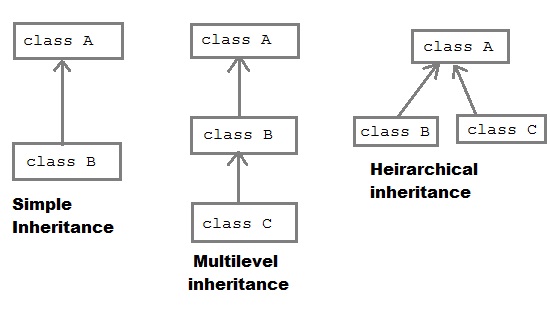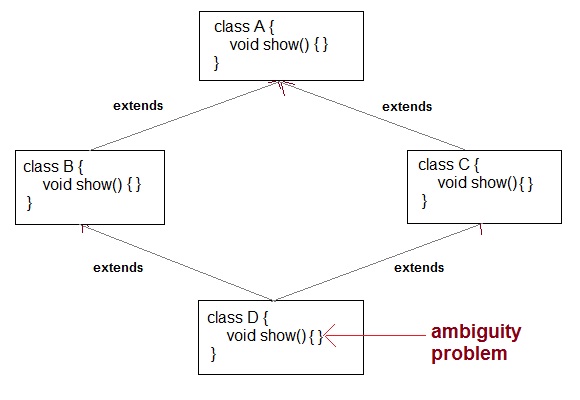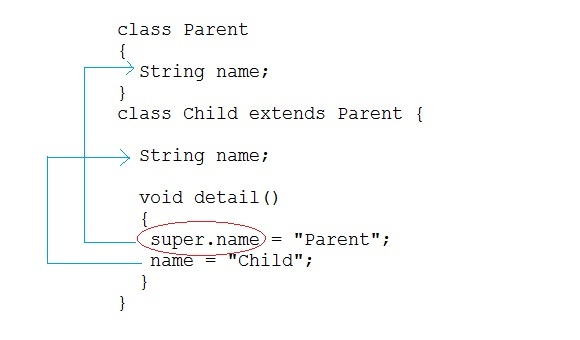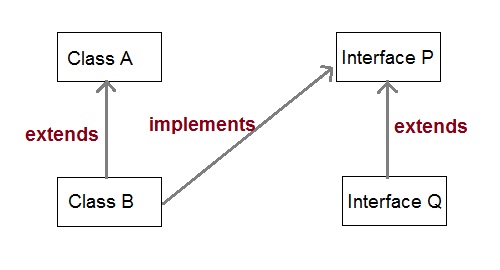Inheritance (IS-A)
Inheritance is one of the key features of Object Oriented Programming. Inheritance provided mechanism that allowed a class to inherit property of another class. When a Class extends another class it inherits all non-private members including fields and methods. Inheritance in Java can be best understood in terms of Parent and Child relationship, also known as Super class(Parent) and Sub class(child) in Java language.
Inheritance defines is-a relationship between a Super class and its Sub class.
extends and implementskeywords are used to describe inheritance in Java.
Let us see how extend keyword is used to achieve Inheritance.
class Vehicle.
{
......
}
class Car extends Vehicle
{
....... //extends the property of vehicle class.
}
Now based on above example. In OOPs term we can say that,
- Vehicle is super class of Car.
- Car is sub class of Vehicle.
- Car IS-A Vehicle.
Purpose of Inheritance
- To promote code reuse.
- To use Polymorphism.
Simple example of Inheritance
class Parent
{
public void p1()
{
System.out.println("Parent method");
}
}
public class Child extends Parent {
public void c1()
{
System.out.println("Child method");
}
public static void main(String[] args)
{
Child cobj = new Child();
cobj.c1(); //method of Child class
cobj.p1(); //method of Parent class
}
}
Output :
Child method Parent method
Another example of Inheritance
class Vehicle
{
String vehicleType;
}
public class Car extends Vehicle {
String modelType;
public void showDetail()
{
vehicleType = "Car"; //accessing Vehicle class member
modelType = "sports";
System.out.println(modelType+" "+vehicleType);
}
public static void main(String[] args)
{
Car car =new Car();
car.showDetail();
}
}
Output :
sports Car
Types of Inheritance
- Single Inheritance
- Multilevel Inheritance
- Heirarchical Inheritance
NOTE :Multiple inheritance is not supported in java

Why multiple inheritance is not supported in Java
- To remove ambiguity.
- To provide more maintainable and clear design.

super keyword
In Java,
super keyword is used to refer to immediate parent class of a class. In other words super keyword is used by a subclass whenever it need to refer to its immediate super class.
Example of Child class refering Parent class property using super keyword
class Parent
{
String name;
}
public class Child extends Parent {
String name;
public void details()
{
super.name = "Parent"; //refers to parent class member
name = "Child";
System.out.println(super.name+" and "+name);
}
public static void main(String[] args)
{
Child cobj = new Child();
cobj.details();
}
}
Output :
Parent and Child
Example of Child class refering Parent class methods using super keyword
class Parent
{
String name;
public void details()
{
name = "Parent";
System.out.println(name);
}
}
public class Child extends Parent {
String name;
public void details()
{
super.details(); //calling Parent class details() method
name = "Child";
System.out.println(name);
}
public static void main(String[] args)
{
Child cobj = new Child();
cobj.details();
}
}
Output :
Parent Child
Example of Child class calling Parent class constructor using super keyword
class Parent
{
String name;
public Parent(String n)
{
name = n;
}
}
public class Child extends Parent {
String name;
public Child(String n1, String n2)
{
super(n1); //passing argument to parent class constructor
this.name = n2;
}
public void details()
{
System.out.println(super.name+" and "+name);
}
public static void main(String[] args)
{
Child cobj = new Child("Parent","Child");
cobj.details();
}
}
Output :
Parent and Child
Super class reference pointing to Sub class object.
In context to above example where Class B extends class A.
A a=new B();is legal syntax because of IS-A relationship is there between class A and Class B.
Q. Can you use both this() and super() in a Constructor?
NO, because both super() and this() must be first statement inside a constructor. Hence we cannot use them together.

No comments:
Post a Comment